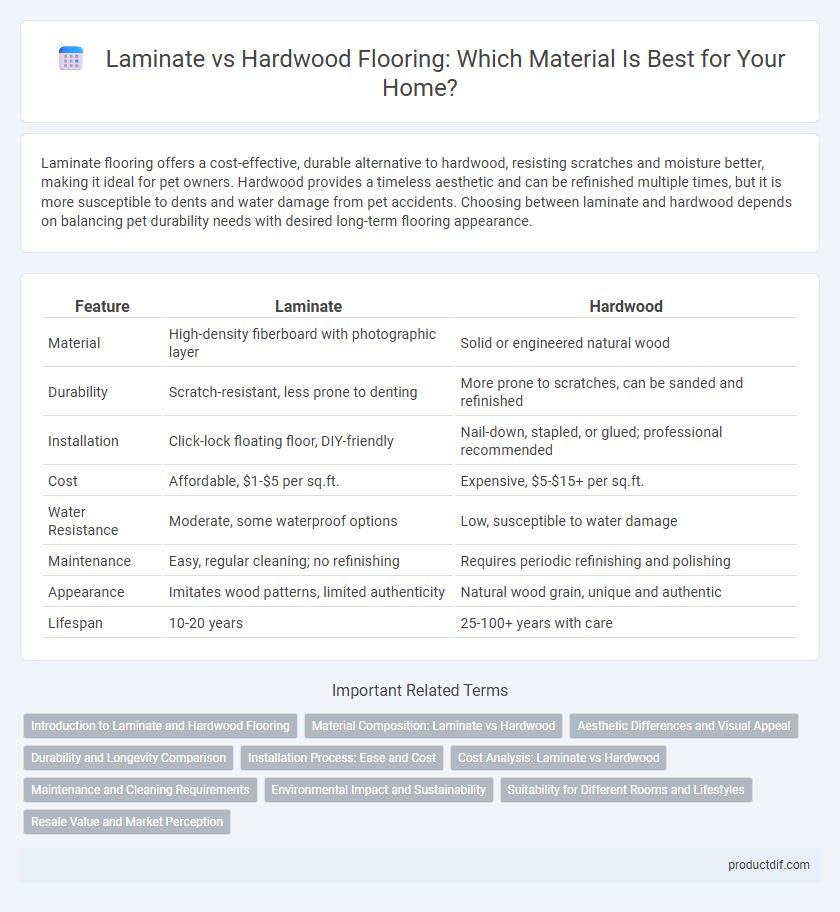Laminate flooring offers a cost-effective, durable alternative to hardwood, resisting scratches and moisture better, making it ideal for pet owners. Hardwood provides a timeless aesthetic and can be refinished multiple times, but it is more susceptible to dents and water damage from pet accidents. Choosing between laminate and hardwood depends on balancing pet durability needs with desired long-term flooring appearance.
Table of Comparison
| Feature | Laminate | Hardwood |
|---|---|---|
| Material | High-density fiberboard with photographic layer | Solid or engineered natural wood |
| Durability | Scratch-resistant, less prone to denting | More prone to scratches, can be sanded and refinished |
| Installation | Click-lock floating floor, DIY-friendly | Nail-down, stapled, or glued; professional recommended |
| Cost | Affordable, $1-$5 per sq.ft. | Expensive, $5-$15+ per sq.ft. |
| Water Resistance | Moderate, some waterproof options | Low, susceptible to water damage |
| Maintenance | Easy, regular cleaning; no refinishing | Requires periodic refinishing and polishing |
| Appearance | Imitates wood patterns, limited authenticity | Natural wood grain, unique and authentic |
| Lifespan | 10-20 years | 25-100+ years with care |
Introduction to Laminate and Hardwood Flooring
Laminate flooring consists of multiple layers fused together, featuring a photographic applique layer that mimics the appearance of natural wood, offering durability and resistance to scratches and moisture. Hardwood flooring is made from solid timber planks or engineered wood, providing authentic grain patterns, long-lasting strength, and the ability to be refinished multiple times. Both options vary in cost, installation methods, and maintenance requirements, making it essential to choose based on lifestyle and aesthetic preferences.
Material Composition: Laminate vs Hardwood
Laminate flooring consists of a high-density fiberboard core layered with a photographic applique of wood grain sealed under a clear wear layer, providing durability and resistance to scratches and moisture. Hardwood flooring is made from solid planks of natural wood species like oak, maple, or cherry, offering authentic texture, natural grain patterns, and the ability to be refinished multiple times. The material composition of laminate emphasizes engineered layers for cost-effectiveness and resilience, while hardwood focuses on natural wood integrity and longevity.
Aesthetic Differences and Visual Appeal
Laminate flooring offers a wide range of designs that mimic the look of hardwood with high photographic realism, providing consistent color and pattern across planks. Hardwood flooring delivers natural variations in grain, texture, and color, creating a unique, warm, and authentic visual appeal that evolves with age. The choice between laminate and hardwood depends on the desired aesthetic authenticity and the preference for natural imperfections versus uniformity.
Durability and Longevity Comparison
Laminate flooring offers high resistance to scratches, dents, and stains due to its protective wear layer, making it ideal for high-traffic areas and homes with pets or children. Hardwood floors, while more susceptible to surface damage, can be sanded and refinished multiple times, significantly extending their lifespan beyond 30 years with proper maintenance. Both materials provide durable options, but hardwood's longevity and ability to restore its original beauty often surpass the typical 15-25 year durability of laminate.
Installation Process: Ease and Cost
Laminate flooring offers a simpler installation process with a click-and-lock system, often suitable for DIY projects, reducing labor costs significantly compared to hardwood. Hardwood installation typically requires professional skills for nailing or gluing down planks, increasing overall expenses. Laminate also installs faster, minimizing downtime and associated costs during renovation.
Cost Analysis: Laminate vs Hardwood
Laminate flooring typically costs between $1 and $5 per square foot, making it a budget-friendly option compared to hardwood, which ranges from $5 to $15 per square foot depending on species and quality. Installation fees for laminate are generally lower due to its click-lock design, reducing labor expenses compared to hardwood that requires nailing or gluing. Long-term costs favor hardwood for its durability and higher resale value, while laminate may need replacement every 10-20 years.
Maintenance and Cleaning Requirements
Laminate flooring requires minimal maintenance, needing only regular sweeping and occasional damp mopping to keep it clean, making it highly resistant to stains and scratches compared to hardwood. Hardwood floors demand more care with periodic refinishing and special cleaning products to preserve their natural finish and prevent water damage. Both options benefit from prompt spill cleanup, but laminate offers superior durability and easier upkeep in high-traffic areas.
Environmental Impact and Sustainability
Laminate flooring generally has a lower environmental impact than hardwood due to its use of composite wood materials derived from recycled fibers and adhesives, reducing the demand for virgin timber. Hardwood flooring, while biodegradable and durable, often requires intensive logging practices that contribute to deforestation and habitat loss unless sourced from certified sustainable forests. Choosing laminate with low-VOC finishes and FSC-certified hardwood can significantly improve sustainability by minimizing emissions and promoting responsible forestry.
Suitability for Different Rooms and Lifestyles
Laminate flooring offers high durability and moisture resistance, making it ideal for kitchens, bathrooms, and high-traffic areas, while hardwood excels in living rooms and bedrooms where its natural beauty and warmth enhance aesthetics. Families with pets and children often prefer laminate due to its scratch resistance and ease of maintenance, whereas hardwood suits homeowners prioritizing longevity and the potential for refinishing over time. The choice depends on lifestyle demands, with laminate providing cost-effective versatility and hardwood delivering timeless elegance.
Resale Value and Market Perception
Hardwood flooring consistently commands higher resale value due to its timeless appeal and perceived durability among homebuyers. Laminate, while more budget-friendly and resistant to scratches, tends to offer lower market perception, often viewed as a less prestigious alternative. Real estate agents frequently recommend hardwood to maximize property value and attract discerning buyers.
Laminate vs Hardwood Infographic

 productdif.com
productdif.com